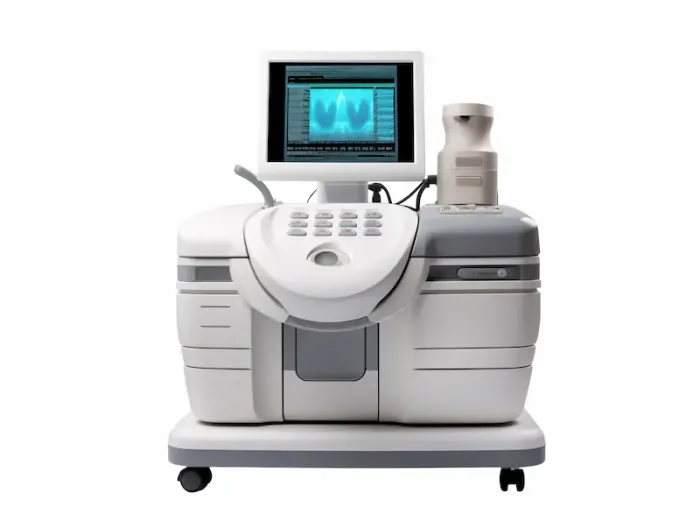FibroScan Simple Early Diagnosis for Liver Disease
Learn how FibroScan helps in the early diagnosis of liver disease. Understand how this quick, non-invasive test measures liver stiffness and detects conditions like fatty liver, fibrosis, or cirrhosis accurately.


Introduction
Liver disease is often silent until it becomes serious. That’s why simple, noninvasive tools that spot trouble early are so valuable. FibroScan is one of those tools—a painless test that measures liver stiffness (a sign of scarring) and fat in just a few minutes. It can help detect problems like fatty liver disease, hepatitis-related damage, or alcohol-related injury long before symptoms appear. Early diagnosis gives you time to make changes, get the right care, and prevent complications.
In this guide, you’ll learn what a FibroScan is, how it works, who should consider it, what to expect at your appointment, and how to interpret kPa and CAP results. We’ll compare FibroScan with ultrasound, MRI, and liver biopsy, discuss safety and accuracy, and share practical next steps if your results suggest liver disease. Whether you’re curious about a screening test your doctor recommended or you’re managing conditions like diabetes or hepatitis, this article will help you understand how FibroScan fits into protecting your liver health.
Why Early Liver Disease Detection Matters?
Most liver conditions—including nonalcoholic fatty liver disease (NAFLD), alcohol-associated liver disease, and chronic viral hepatitis—develop quietly. You may have normal energy, no pain, and normal-looking skin while inflammation and scarring slowly build. By the time symptoms like jaundice, swelling, or confusion appear, damage can be advanced.
How early detection changes outcomes?
The earlier scarring (fibrosis) is identified, the more reversible it often is. Studies show lifestyle changes that reduce liver fat—losing 7–10% of body weight, for example—can halt or even reverse fibrosis in many people with NAFLD. Noninvasive tests like FibroScan help catch “silent” disease when it’s most responsive to diet, exercise, and targeted medications. Health systems and liver societies increasingly recommend simple risk scores (like FIB-4) followed by FibroScan in primary care to triage who needs specialist care sooner. AASLD guidance endorses VCTE (FibroScan) as a key step: <8 kPa suggests low risk of advanced scarring, 8–12 may need closer review, and >12 raises concern for advanced fibrosis or cirrhosis requiring specialist input.
Real-world timelines: fatty liver to fibrosis to cirrhosis
Progression varies. Some people remain stable for years; others progress faster due to diabetes, obesity, ongoing alcohol use, or coexisting hepatitis. The path often moves from fat accumulation (steatosis) to inflammation (steatohepatitis) to fibrosis and, in some, cirrhosis. Early diagnosis with a simple FibroScan can change that trajectory by triggering timely intervention.
What Is a FibroScan?
Here’s what you need to know about FibroScan:
The basics: stiffness (kPa) and fat (CAP)
FibroScan uses gentle vibrations to measure how stiff your liver is—reported in kilopascals (kPa). Stiffer livers tend to have more scarring. The device also estimates fat using the controlled attenuation parameter (CAP), reported in dB/m. One quick session provides both numbers to guide care.
FibroScan vs standard ultrasound
A standard ultrasound shows structure—size, texture, signs of cirrhosis or masses—but doesn’t quantify scarring or fat very well. FibroScan quantifies stiffness and fat, functioning like a “liver health scorecard.” Together, they can provide a fuller picture: ultrasound for anatomy, FibroScan for disease stage.
When a FibroScan is preferred over a biopsy
Liver biopsy provides microscopic detail but is invasive, can be painful, and samples only a tiny fraction of liver tissue. For many situations—like monitoring NAFLD or chronic hepatitis—FibroScan offers a safe, repeatable, and cost-effective alternative to biopsy to stage disease, track changes over time, and decide who truly needs a biopsy.
Consult Top Specialists
How FibroScan Works?
Let’s see how a FibroScan works:
Vibration-Controlled Transient Elastography explained
FibroScan is a type of elastography. A small probe placed on your skin sends a harmless “push” (a low-frequency vibration) through the liver; ultrasound waves then measure how fast that wave travels. The faster it travels, the stiffer the liver, and the higher the kPa value. The test typically takes 5–10 minutes and requires 10 valid measurements for reliability.
CAP: quantifying fatty liver
The same probe measures how much the ultrasound signal is dampened by fat, producing a CAP score. Higher CAP suggests more fat. Clinicians may categorize CAP into broad steatosis grades to guide lifestyle advice and follow-up.
Why fasting and probe selection matter (M vs XL)
Eating a heavy meal or having acute inflammation can transiently increase liver stiffness. That’s why most centers ask you to fast for at least 2–3 hours before the test. People with higher body mass index (BMI) may need an XL probe to improve accuracy; trained operators will choose the right probe based on your body habitus to reduce technical failures.
Who Should Consider a FibroScan?
Here’s who should consider a FibroSCan:
At-risk groups (NAFLD, diabetes, obesity, hepatitis B/C, alcohol use)
You should discuss FibroScan with your clinician if you have:
• NAFLD or metabolic risk factors (type 2 diabetes, obesity, high triglycerides)
• Chronic hepatitis B or C
• Regular heavy alcohol use or alcohol-associated liver disease
• Abnormal liver blood tests (ALT, AST, GGT) without a clear cause
• Family history of liver cirrhosis or hereditary liver disease
Red flags that warrant sooner evaluation
Seek prompt evaluation if you have unexplained fatigue, right upper abdominal discomfort, signs of advanced disease (abdominal swelling, leg oedema), or lab abnormalities. If symptoms persist beyond two weeks, consult a doctor online with Apollo 24|7 for further evaluation; they can guide whether a FibroScan or lab panel is appropriate.
Primary care pathway: FIB-4 to FibroScan
A common pathway is to calculate a FIB-4 score (using age, AST, ALT, platelet count). Low-risk FIB-4 may be monitored; intermediate or high scores often trigger FibroScan (VCTE) for better staging. AASLD suggests VCTE thresholds: <8 kPa typically rules out advanced fibrosis; 8–12 is indeterminate; >12 suggests advanced fibrosis/cirrhosis and merits specialist review. Apollo 24|7 offers convenient home collection for liver function tests or viral hepatitis screening if needed to complete this pathway.
Your Appointment: Before, During, and After
Here’s what you do and what happens before, during and after the scan:
Preparing (fasting, medications, clothing)
• Fast 2–3 hours; water is usually allowed
• Wear a two-piece outfit so your right abdomen can be exposed
• Take routine medications unless your clinician advises otherwise.
• Bring a list of medications and prior test results.
What you’ll feel and how long it takes
You’ll lie on your back with your right arm raised. The operator places gel and a small probe between your ribs. You’ll feel gentle taps—no needles, no sedation. Most exams take 5–10 minutes. The operator aims for at least 10 valid readings; the device averages them and reports variability, which helps assess reliability.
Getting results and next steps
Results are often available immediately. You’ll receive a liver stiffness (kPa) and CAP (fat) value. Your clinician will interpret these in context—your age, body type, labs, and underlying condition—because some conditions temporarily elevate stiffness (e.g., acute hepatitis, heart failure, cholestasis). If your results are borderline or high, you may be referred to a liver specialist. If your condition does not improve after trying recommended lifestyle changes, book a physical visit to a doctor with Apollo 24|7 for ongoing care.
Consult Top Specialists
Making Sense of Your Results
Here’s how you can interpret the results:
Typical kPa categories and what they suggest
While exact cut-offs vary by disease and lab, patient-facing guides offer broad categories:
• Roughly 2–7 kPa: typical of healthy or minimal scarring
• Around 7–9 kPa: possible mild fibrosis
• 9–12 kPa: possible moderate fibrosis
• >12–14 kPa: suggests advanced fibrosis or cirrhosis
These ranges are general; clinicians adjust for etiology (e.g., NAFLD, hepatitis B/C), BMI, and inflammation. AASLD NAFLD guidance supports using <8, 8–12, and >12 kPa bands for risk stratification in primary care, prompting either reassurance, closer follow-up, or specialist referral.
Understanding CAP scores and fatty liver grades
CAP is reported in dB/m and correlates with steatosis. Higher CAP indicates more liver fat. While exact thresholds differ between centres, rising CAP over time suggests worsening fatty liver, whereas reductions often accompany weight loss and improved metabolic health. CAP can be especially motivating—seeing the number fall can reinforce lifestyle progress.
False positives: inflammation, congestion, cholestasis
Stiffness can rise for reasons other than scarring:
• Acute hepatitis or flares (ALT spikes)
• Cardiac congestion (heart failure)
• Extrahepatic cholestasis (e.g., gallstones obstructing bile flow)
That’s why results should be interpreted with recent labs and clinical context. If your kPa is high but you recently had an illness or lab spike, your clinician may repeat the test after recovery.
FibroScan vs Other Liver Tests
Here’s a comparison between FibroScan and other liver tests:
FibroScan vs MRI elastography vs ultrasound
• Ultrasound: excellent for anatomy, masses, and advanced cirrhosis signs, but not quantitative for scarring or fat.
• MRI elastography: highly accurate for fibrosis and can map the entire liver; more expensive and less accessible.
• FibroScan (VCTE): fast, bedside, widely available, strong accuracy for ruling out advanced fibrosis in many diseases; ideal for triage and monitoring. For NAFLD, meta-analyses report good diagnostic performance with area under the curve often around 0.85–0.90 for advanced fibrosis.
FibroScan vs liver biopsy: when tissue is still needed
Biopsy remains valuable when the diagnosis is uncertain, when autoimmune or rare diseases are suspected, or when noninvasive tests conflict. Many guidelines now reserve biopsy for select cases, using FibroScan to monitor most patients over time. A pragmatic approach: use FIB-4 and FibroScan to narrow uncertainty; proceed to biopsy when results will clearly change management.
Safety, Accuracy, and Limitations
Let’s have a look at the accuracy and limitations of FibroScan:
How accurate is FibroScan for different diseases?
Accuracy varies by aetiology and cut-offs. For advanced fibrosis, FibroScan generally has high negative predictive value—meaning a low kPa reliably rules out severe scarring—making it an excellent triage test. In NAFLD and viral hepatitis, performance is strong; in cholestatic diseases, thresholds differ. CAP reliably gauges fat but is less precise than MRI-PDFF for small changes.
When results can be unreliable (technical and biological)
• High BMI without XL probe selection can lead to failures or overestimates
• Narrow rib spaces or ascites can hinder readings
• Recent meals, acute inflammation, extrahepatic cholestasis, or right-sided heart failure can inflate kPa.
• An interquartile range/median ratio (IQR/M) >30% suggests less reliable results; trained operators review this metric.
Pediatric, pregnancy, and implanted devices considerations
FibroScan is generally considered safe; no ionising radiation and no injections. It’s used increasingly in children and during pregnancy when indicated, but specialised expertise improves reliability. People with implantable devices can usually undergo FibroScan safely; always tell your clinician about pacemakers or implants so they can follow manufacturer guidance.
What to Do After a FibroScan?
Here’s what to do after a FibroScan:
Lifestyle changes that reverse early disease
• Aim for 7–10% weight loss if overweight; even 5% can reduce liver fat
• Emphasise Mediterranean-style eating: vegetables, fruits, legumes, whole grains, nuts, olive oil; limit added sugar and refined carbs.
• Limit alcohol; for many with fatty liver, abstinence is recommended.
• Exercise: 150–300 minutes/week of moderate activity plus resistance training improves liver fat independent of weight loss.
• Manage comorbidities: diabetes, cholesterol, blood pressure.
Medication and specialist referral
Certain medications (e.g., GLP-1 receptor agonists for diabetes/obesity) can aid weight loss and improve liver parameters; antiviral therapy is crucial for hepatitis B/C; and disease-specific treatments exist for autoimmune or cholestatic conditions. Abnormal or rising kPa/CAP often warrants referral to a hepatologist. If symptoms persist beyond two weeks or your results are in the indeterminate/high range, consult a doctor online with Apollo 24|7 to plan next steps.
Monitoring schedule if results are borderline
If your kPa is 8–12 or CAP is high, your clinician may repeat FibroScan in 6–12 months after lifestyle changes and update labs. Apollo 24|7 offers home collection for follow-up tests like liver function tests (ALT/AST), HbA1c, lipid profile, and hepatitis panels.Consult Top Specialists
Conclusion
Liver disease doesn’t have to catch you by surprise. With a simple, noninvasive FibroScan, you can assess liver scarring and fat in minutes—no needles, no sedation, and often immediate results. For people at risk—those with diabetes, extra weight, chronic viral hepatitis, or regular alcohol use—this test can be the difference between catching disease early and dealing with complications later. Interpreting kPa and CAP values is most meaningful when combined with your history, labs, and risk factors. That’s why FibroScan works best as part of a clear pathway: basic labs and FIB-4 in primary care, followed by FibroScan to refine risk, then targeted lifestyle changes, medications when needed, and appropriate specialist referral.
If your numbers are low, a healthy routine and periodic rechecks may be enough. If they’re borderline or elevated, you have actionable options now. Small steps—losing a modest amount of weight, moving more, limiting alcohol—can change your trajectory. And if you need expert guidance, you don’t have to go it alone. If symptoms persist or your results concern you, consult a doctor online with Apollo 24|7 to map out your next steps. For convenience, consider home collection of follow-up labs like liver function tests or hepatitis panels. Early knowledge is powerful; FibroScan makes getting it simple.
Consult Top Specialists

Dr. Srinivasa Reddy
Hepatologist
12 Years • MBBS, MD (General Medicine), DM (Hepatology),ASGE
Hyderabad
Myra Liver & Gastro Care, Hyderabad

Dr. E Prabhakar Sastry
General Physician/ Internal Medicine Specialist
40 Years • MD(Internal Medicine)
Manikonda Jagir
Apollo Clinic, Manikonda, Manikonda Jagir
(150+ Patients)

Dr. Sushith C
General Physician
2 Years • MBBS
Bengaluru
PRESTIGE SHANTHINIKETAN - SOCIETY CLINIC, Bengaluru

Dr. Pavan Kumar Y M
Gastroenterology/gi Medicine Specialist
5 Years • MBBS, MD Medicine, DM Gastroenterology
Bengaluru
Apollo Medical Center, Marathahalli, Bengaluru
Consult Top Specialists

Dr. Srinivasa Reddy
Hepatologist
12 Years • MBBS, MD (General Medicine), DM (Hepatology),ASGE
Hyderabad
Myra Liver & Gastro Care, Hyderabad

Dr. E Prabhakar Sastry
General Physician/ Internal Medicine Specialist
40 Years • MD(Internal Medicine)
Manikonda Jagir
Apollo Clinic, Manikonda, Manikonda Jagir
(150+ Patients)

Dr. Sushith C
General Physician
2 Years • MBBS
Bengaluru
PRESTIGE SHANTHINIKETAN - SOCIETY CLINIC, Bengaluru

Dr. Pavan Kumar Y M
Gastroenterology/gi Medicine Specialist
5 Years • MBBS, MD Medicine, DM Gastroenterology
Bengaluru
Apollo Medical Center, Marathahalli, Bengaluru
Consult Top Specialists

Dr. Srinivasa Reddy
Hepatologist
12 Years • MBBS, MD (General Medicine), DM (Hepatology),ASGE
Hyderabad
Myra Liver & Gastro Care, Hyderabad

Dr. E Prabhakar Sastry
General Physician/ Internal Medicine Specialist
40 Years • MD(Internal Medicine)
Manikonda Jagir
Apollo Clinic, Manikonda, Manikonda Jagir
(150+ Patients)

Dr. Sushith C
General Physician
2 Years • MBBS
Bengaluru
PRESTIGE SHANTHINIKETAN - SOCIETY CLINIC, Bengaluru

Dr. Pavan Kumar Y M
Gastroenterology/gi Medicine Specialist
5 Years • MBBS, MD Medicine, DM Gastroenterology
Bengaluru
Apollo Medical Center, Marathahalli, Bengaluru
Frequently Asked Questions
1) How do I prepare for a FibroScan?
Fast for about 2–3 hours; water is typically allowed. Wear a two-piece outfit. Continue your usual medications unless advised otherwise. This helps ensure accurate liver stiffness measurement.
2) What is a normal FibroScan kPa result?
Normal ranges vary, but many centers consider roughly 2–7 kPa as typical of healthy or minimal scarring. In primary care pathways, <8 kPa often rules out advanced fibrosis; 8–12 is indeterminate; >12 suggests advanced fibrosis. Always interpret results with your doctor.
3) Can FibroScan replace a liver biopsy?
Often, yes—especially for monitoring NAFLD or hepatitis. But biopsy may still be needed when diagnosis is uncertain, noninvasive tests conflict, or treatment decisions hinge on histology. Discuss FibroScan vs liver biopsy with your clinician.
4) Does obesity affect FibroScan accuracy?
Higher BMI can make measurements more difficult. Using the XL probe and ensuring fasting improves accuracy. Ask if your center has both M and XL probes and experienced operators.
5) How often should I repeat a FibroScan?
If you have risk factors or borderline results (e.g., 8–12 kPa), many clinicians repeat the noninvasive liver fibrosis test every 6–12 months, alongside lifestyle changes and updated labs.
